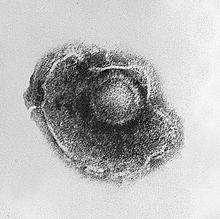- Varicella zoster virus
-
Varicella zoster virus 
Micrograph of VZV. Virus classification Group: Group I (dsDNA) Family: Herpesviridae Subfamily: Alphaherpesvirinae Genus: Varicellovirus Species - Human herpesvirus 3 (HHV-3)
Varicella zoster virus (VZV) is one of eight herpes viruses known to infect humans (and other vertebrates). It commonly causes chicken-pox in children and Herpes zoster (shingles) in adults and rarely in children.
Contents
Nomenclature
Varicella-zoster virus is known by many names, including: chickenpox virus, varicella virus, zoster virus, and human herpes virus type 3 (HHV-3).
Human disease
Primary VZV infection results in chickenpox (varicella), which may rarely result in complications including encephalitis or pneumonia. Even when clinical symptoms of chickenpox have resolved, VZV remains dormant in the nervous system of the infected person (virus latency), in the trigeminal and dorsal root ganglia.[1] In about 10–20% of cases, VZV reactivates later in life producing a disease known as shingles. Serious complications of shingles include postherpetic neuralgia, zoster multiplex, myelitis, herpes ophthalmicus, or zoster sine herpete.
Morphology
VZV is closely related to the herpes simplex viruses (HSV), sharing much genome homology. The known envelope glycoproteins (gB, gC, gE, gH, gI, gK, gL) correspond with those in HSV, however there is no equivalent of HSV gD. VZV also fails to produce the LAT (latency-associated transcripts) that play an important role in establishing HSV latency (herpes simplex virus). VZV virons are spherical and 150–200 nm in diameter. Their lipid envelope encloses the nucleocapsid of 162 capsomeres arranged in an icosahedral form.[2] Its DNA is a single, linear, double-stranded molecule, 125,000 nt long. The capsid is surrounded by a number of loosely associated proteins known collectively as the tegument; many of these proteins play critical roles in initiating the process of virus reproduction in the infected cell. The tegument is in turn covered by a lipid envelope studded with glycoproteins that are displayed on the exterior of the virion.
Treatment
The virus is very susceptible to disinfectants, notably sodium hypochlorite. Within the human body it can be treated by a number of drugs and therapeutic agents including acyclovir for the chicken pox, famciclovir, valaciclovir for the shingles, zoster-immune globulin (ZIG), and vidarabine. VZV immune globulin is also a treatment.
Vaccination
A live attenuated VZV Oka/Merck strain vaccine is available and is marketed in the United States under the trade name Varivax. It was developed by Merck, Sharp & Dohme in the 1980s from the Oka strain virus isolated and attenuated by Michiaki Takahashi and colleagues in the 1970s. It was submitted to the U.S. Food and Drug Administration for approval in 1990 and was approved in 1995. Since then, it has been added to the recommended vaccination schedules for children in Australia, the United States, and many other countries. Varicella vaccination has raised concerns in some that the immunity induced by the vaccine may not be lifelong, possibly leaving adults vulnerable to more severe disease as the immunity from their childhood immunization wanes. Vaccine coverage in the United States in the population recommended for vaccination is approaching 90%, with concomitant reductions in the incidence of varicella cases and hospitalizations and deaths due to VZV. So far, clinical data has proved that the vaccine is effective for over 10 years in preventing varicella infection in healthy individuals and when breakthrough infections do occur, illness is typically mild.[2] In 2007, the ACIP recommended a second dose of vaccine before school entry to ensure the maintenance of high levels of varicella immunity.[3]
In 2006, the United States Food and Drug Administration approved Zostavax for the prevention of shingles. Zostavax is a more concentrated formulation of the Varivax vaccine, designed to elicit an immune response in older adults whose immunity to VZV wanes with advancing age.[4]
See also
References
- ^ Steiner I, Kennedy PG, Pachner AR (2007). "The neurotropic herpes viruses: herpes simplex and varicella-zoster". Lancet Neurol 6 (11): 1015–28. doi:10.1016/S1474-4422(07)70267-3. PMID 17945155.
- ^ "Prevention of varicella: Recommendations of the Advisory Committee on Immunization Practices (ACIP). Centers for Disease Control and Prevention". MMWR Recomm Rep 45 (RR–11): 1–36. July 1996. PMID 8668119. http://www.cdc.gov/mmwr/preview/mmwrhtml/00042990.htm.
- ^ Marin M, Güris D, Chaves SS, Schmid S, Seward JF (June 2007). "Prevention of varicella: recommendations of the Advisory Committee on Immunization Practices (ACIP)". MMWR Recomm Rep 56 (RR–4): 1–40. PMID 17585291. http://www.cdc.gov/mmwr/preview/mmwrhtml/rr5604a1.htm.
- ^ Poland GA (October 2005). "The growing paradigm of preventing disease: vaccines to prevent herpes zoster and pertussis in adults". Ann. Intern. Med. 143 (7): 539–41. PMID 16204167. http://www.annals.org/content/143/7/539.
External links
Varicella zoster Infections Other Infectious skin disease: Viral cutaneous conditions, including viral exanthema (B00–B09, 050–059) HSV (Herpes simplex, Herpetic whitlow, Herpes gladiatorum, Herpetic keratoconjunctivitis, Herpetic sycosis, Neonatal herpes simplex, Herpes genitalis, Herpes labialis, Eczema herpeticum, Herpetiform esophagitis) · Herpes B virus (B virus infection)VZV (Chickenpox, Herpes zoster, Herpes zoster oticus, Ophthalmic zoster, Disseminated herpes zoster, Zoster-associated pain, Inflammatory skin lesions following zoster infection, Modified varicella-like syndrome)SealpoxOtherPapillomaviridaeHPV (Wart/Plantar wart, Heck's disease, Genital wart (giant), Laryngeal papillomatosis, Butcher's wart, Bowenoid papulosis, Epidermodysplasia verruciformis, Verruca plana, Pigmented wart, Verrucae palmares et plantares )
BPV (Equine sarcoid)Parvovirus B19 (Erythema infectiosum, Reticulocytopenia, Papular purpuric gloves and socks syndrome)CAV (Hand, foot and mouth disease, Herpangina) · FMDV (Foot-and-mouth disease) · Boston exanthem diseaseUngrouped unknown/multiple: Asymmetric periflexural exanthem of childhood · Post-vaccination follicular eruption · Lipschütz ulcer · Eruptive pseudoangiomatosis · Viral-associated trichodysplasia · Gianotti–Crosti syndromeCategories:- Chickenpox
- Herpesviruses
- Viral diseases
Wikimedia Foundation. 2010.
